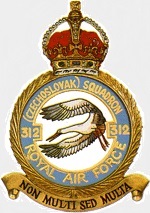Hobby Master HA8305 RAF Supermarine Spitfire Mk. IXc Fighter - Otto Smik, No.312 (Czech) Squadron, 1944 (1:48 Scale)
"Never in the field of human conflict was so much owed by so many to so few."
- British Prime Minister Winston Churchill, commenting on the British airmen in the Battle of Britain
 The Spitfire is the most famous British aircraft of all time. Although less numerous than the Hawker Hurricane, it is remembered as the sleek, thoroughbred fighting machine that turned the tide during the Battle of Britain. The Spitfire was among the fastest and most maneuverable prop-driven fighters of World War II, serving in virtually every combat theater.
The Spitfire is the most famous British aircraft of all time. Although less numerous than the Hawker Hurricane, it is remembered as the sleek, thoroughbred fighting machine that turned the tide during the Battle of Britain. The Spitfire was among the fastest and most maneuverable prop-driven fighters of World War II, serving in virtually every combat theater.
Supermarine designer Reginald Mitchell created this small, graceful, elliptical-wing fighter with eight guns in the wings that were able to fire without being hindered by the propeller. The immortal Spitfire thus became not merely one of the best-performing fighters of all time, but also one of the best-looking. Although never employed as a long-range escort, the Spitfire was a champion in an air-to-air duel. Spitfires routinely dived at the speed of sound, faster than any of the German jets.
A carrier-based version, called the Seafire, was a winner in its own right, serving valiantly on convoy routes during World War II. The Seafire 47 was even used in the early stages of the Korean War, before it was replaced by more modern jet aircraft.
Pictured here is a 1:48 scale replica of a Supermarine Spitfire Mk. IXc fighter that was piloted by Otto Smik, who was attached to No.312 (Czech) Squadron, during 1944.
Sold Out!
Dimensions:
Wingspan: 9-inches
Length: 7-1/2-inches
Release Date: July 2013
 Historical Account: "Czech-Mates" - No.312 Squadron RAF was a Czechoslovak-manned fighter squadron of the Royal Air Force during the Second World War. It was first formed at Duxford in July 1940, equipped with Hurricane I fighters and crewed mostly by escaped Czechoslovak pilots. Its first victory was a Junkers Ju 88 above Liverpool by Alois Vatko, Denys Gillam and Josef Stehlk on October 8th, 1940. During April and early May, 1941, the squadron was briefly stationed at RAF Jurby, Isle of Man. No.312 Squadron transitioned to Hurricane IIs in May 1941, and to Spitfires in October. It operated the Spitfires from the west of England during 1942 mainly operating coastal patrols and shipping reconnaissance flights. In September 1943, it joined the 2nd Tactical Air Force as a fighter-bomber unit with the Spitfire IX. The squadron operated over France softening up targets in preparation for the invasion and then supporting the landings. In July 1944, the squadron moved to RAF Coltishall and operated daytime bomber escort flight over continental Europe. Following the end of the war the squadron moved to Prague in August 1945 before being disbanded on transfer to the Czechoslovak air force in February 1946.
Historical Account: "Czech-Mates" - No.312 Squadron RAF was a Czechoslovak-manned fighter squadron of the Royal Air Force during the Second World War. It was first formed at Duxford in July 1940, equipped with Hurricane I fighters and crewed mostly by escaped Czechoslovak pilots. Its first victory was a Junkers Ju 88 above Liverpool by Alois Vatko, Denys Gillam and Josef Stehlk on October 8th, 1940. During April and early May, 1941, the squadron was briefly stationed at RAF Jurby, Isle of Man. No.312 Squadron transitioned to Hurricane IIs in May 1941, and to Spitfires in October. It operated the Spitfires from the west of England during 1942 mainly operating coastal patrols and shipping reconnaissance flights. In September 1943, it joined the 2nd Tactical Air Force as a fighter-bomber unit with the Spitfire IX. The squadron operated over France softening up targets in preparation for the invasion and then supporting the landings. In July 1944, the squadron moved to RAF Coltishall and operated daytime bomber escort flight over continental Europe. Following the end of the war the squadron moved to Prague in August 1945 before being disbanded on transfer to the Czechoslovak air force in February 1946.
Among other major operations, it flew in cover of the Operation Jubilee raid on Dieppe in 1942, losing one aircraft.
Seven Spitfire FMk.IXs survive today that flew with the squadron in 1944-45. This is by far the largest number of surviving aircraft associated with a single squadron.






